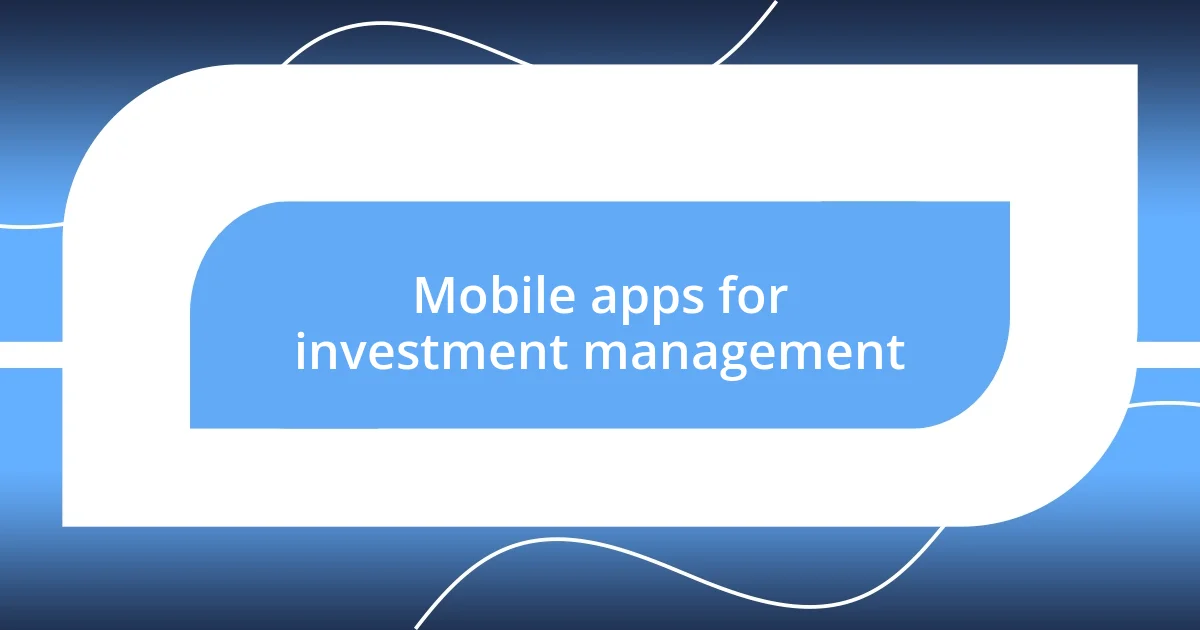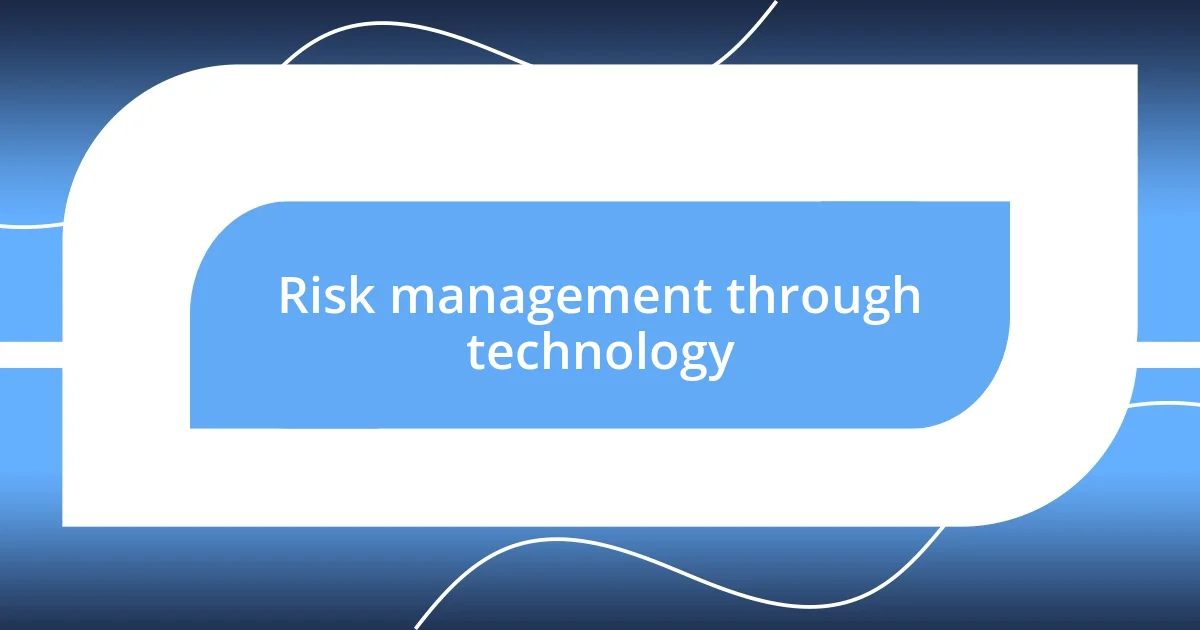Key takeaways:
- Technology has transformed investing by providing tools for data analysis, automation, and access to real-time market information, empowering both novice and experienced investors.
- Automation and algorithmic trading have minimized emotional decision-making, enabling a systematic and disciplined approach to investing.
- The future of investing technology is poised for growth with advancements in AI, decentralized finance (DeFi), and blockchain, enhancing efficiency, transparency, and security in financial transactions.

Understanding technology in investing
Technology has revolutionized the investing landscape, transforming how we analyze data and make decisions. I still remember the first time I used an investment app; it felt like I had a financial advisor in my pocket. Isn’t it incredible how a few taps can provide access to real-time market data and sophisticated analysis tools?
With tools like robo-advisors, even novice investors can benefit from algorithm-driven insights that were once reserved for the pros. I often reflect on how daunting the investing world seemed before these advancements; now, I can tailor my portfolio to my goals with just a few clicks. Have you ever thought about how much easier it is to make informed decisions with technology at our fingertips?
Moreover, the rise of social media and investment platforms has created communities where ideas and strategies are shared at lightning speed. I recall joining a trading group online where I found camaraderie and learned so much from others’ experiences. It made me wonder: how crucial are these connections in shaping our investment strategies today?

Tools for analyzing investments
Analyzing investments today has become an exciting blend of data and technology. I often find myself relying on specialized software and apps that not only present raw data but also help me interpret it. Recently, while analyzing a stock, I used a tool that provided graphical representations of its historical performance. It gave me insights I hadn’t considered and transformed data into a story that helped me decide my next move.
Some of my favorite tools for analyzing investments include:
- Stock Screeners: Quick filters for narrowing down stocks based on specific criteria.
- Charting Software: Visual aids to analyze price trends and patterns.
- Financial News Aggregators: Platforms that collect headlines and articles to keep me updated on market sentiment.
- Portfolio Management Systems: Comprehensive tools that help track performance and diversification.
- Investment Research Platforms: Access to in-depth reports and analyst ratings, which offer a wealth of knowledge.
Each tool plays a crucial role in shaping my investment decisions, making sure I’m well-informed and confident in my choices.

Automation in investment strategies
Automation in investment strategies has dramatically changed my approach to investing. I remember when I first set up automated contributions to my investment account; it felt like a weight was lifted off my shoulders. I was pleasantly surprised by how much easier it was to stay consistent, which is crucial for building wealth over time. The idea of ‘set it and forget it’ resonates deeply with me, as I find comfort knowing my investments are regularly funded, even when life gets busy.
One striking advantage of automation is its ability to minimize emotional trading. There’s a certain thrill in watching the market, but I’ve learned that reacting impulsively can lead to poor decisions. With automated trading strategies, I’m able to maintain discipline. For example, utilizing algorithms to buy or sell at predetermined price points means I can detach from the emotional highs and lows of the market. This has truly transformed my investing experience, making it much more about strategy than feelings.
Incorporating automation not only increases efficiency but also helps manage my portfolio with greater precision. I utilize rebalancing tools that automatically adjust my asset allocation based on market changes. The first time I received an alert about a rebalancing action, I felt a rush of assurance. I knew that my portfolio was working towards my long-term goals without needing constant oversight. Have you thought about how automation can streamline your own investment process?
| Investment Automation Tool | Description |
|---|---|
| Automated Contributions | Regularly invest fixed amounts into your investment accounts without manual input. |
| Robo-Advisors | Algorithm-driven services that create and manage a diversified portfolio based on your risk profile. |
| Automated Trading Systems | Predefined trades executed automatically based on market conditions or alerts. |
| Rebalancing Tools | Adjust investments automatically to maintain desired asset allocation. |

Utilizing algorithms for trading
Utilizing algorithms for trading has been a game changer for me, especially when I think about the sheer volume of trades that happen every second in the market. I once experimented with a trading algorithm that analyzed patterns across multiple stocks, making trades in real-time based on historical data. The thrill of watching the algorithm execute trades without my direct input was exhilarating—it felt like I had my own trading assistant that never slept.
What I appreciate most about algorithmic trading is its systematic approach. Algorithms are designed to follow a defined strategy, which helps eliminate human bias and emotional errors. I remember when I relied heavily on instinct and market rumors; the losses I incurred were painful lessons. Now, I find comfort in knowing my trades are based on solid data, consistently executed, and devoid of the anxiety that often clouds our judgment. Have you ever wished you could freeze the noise of the market and just let numbers guide your decisions?
Furthermore, the flexibility of setting parameters for trades is astonishing. I can adjust my algorithms based on market fluctuations and my risk tolerance. After implementing an algorithm to trigger trades when certain technical indicators align, I felt a sense of empowerment. It was as if I’d tapped into a powerful tool that not only informed my decisions but also provided a layer of protection during volatile market conditions. I sometimes wonder how many investors are still navigating the unpredictable waters of trading without the help of technology.

Mobile apps for investment management
Mobile apps for investment management have fundamentally reshaped how I approach my investments. I recall the first time I downloaded a renowned investment app; it felt like I had the stock market right in my pocket. The ability to check my portfolio at a moment’s notice brought a sense of control and confidence that I didn’t anticipate. Have you ever found yourself scrolling through financial news and realized how easily accessible information can impact your decisions?
One feature I particularly value is the seamless integration of real-time data. These apps not only provide current prices but also offer insights into market trends and news that can affect my investments. I remember an instance when I received an alert on my phone about a significant market shift. Thanks to the app, I quickly adjusted my strategy instead of waiting until I could access a computer. Can you imagine missing an opportunity because you weren’t tuned in?
Moreover, the social investing aspect of some apps has introduced an exciting layer to my investment journey. I can follow other investors’ strategies and share insights with a community of like-minded individuals. The first time I engaged in a discussion with another user about a stock pick, it felt invigorating. It’s fascinating how technology fosters a sense of belonging in what can often be a solitary endeavor. Have you considered how being part of such a community could enhance your investing experience?

Risk management through technology
Risk management through technology
I often reflect on how technology has dramatically transformed my approach to risk management. One of the most effective tools I’ve utilized is predictive analytics software, which helps me foresee potential market downturns based on historical trends. For example, last year, I noticed an unusual dip in sector performance; my predictive software flagged it, allowing me to hedge my positions before the downturn occurred. Have you ever wondered how many opportunities slip by unnoticed when relying solely on instinct?
What truly enhances my risk management is the use of advanced charting tools, which display potential scenarios based on volatility. When I first started investing, I was overwhelmed by the sheer unpredictability of the markets. However, once I integrated these tools, I could visually analyze potential price movements, which provided clarity in turbulent times. It’s as if I’ve been given a roadmap through a foggy landscape—granting me the insight needed to navigate potential pitfalls. Have you ever felt lost in market fluctuations, wishing for a clearer path?
Moreover, I can’t stress enough the importance of setting automated alerts for significant price changes or market events. The first time I implemented this feature, I was having dinner when an alert buzzed on my phone, notifying me of a sharp price drop in one of my holdings. I could quickly assess the situation and decide whether to sell or hold without being glued to my screen. It was a small moment, but it underscored how technology allows me to manage risk effectively while still enjoying life outside the trading desk. How would your investing strategy change if you had that level of responsiveness integrated into your daily routine?

Future trends in investing technology
The future of investing technology is exciting, particularly with the rise of artificial intelligence. I’ve recently started exploring AI-driven investment platforms that analyze vast amounts of market data in real-time. The first time I used one, I was astounded by how quickly it processed information compared to traditional methods. Have you ever wished you could make decisions based on comprehensive data analysis rather than gut feelings?
Another trend I’m noticing is the increasing popularity of decentralized finance (DeFi) tools. As I dove into this space, I was struck by how DeFi allows me to manage my investments with increased transparency and fewer intermediaries. Just last week, I completed a transaction that normally would have taken days through traditional banking, and it was done in mere minutes. Imagine how much time you could save and how that could impact your returns!
Lastly, I’m particularly excited about the advancements in blockchain technology for secure transactions. Recently, I participated in a blockchain-based investment round, which opened my eyes to how this technology can enhance trust in the investment process. It’s fascinating to think about how transparent and secure our investments can become, reducing the fear of fraud that so often accompanies financial dealings. What possibilities do you see emerging with such innovations?














